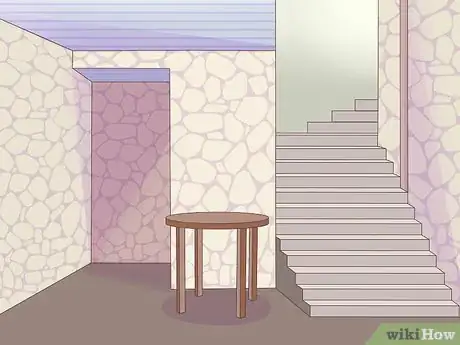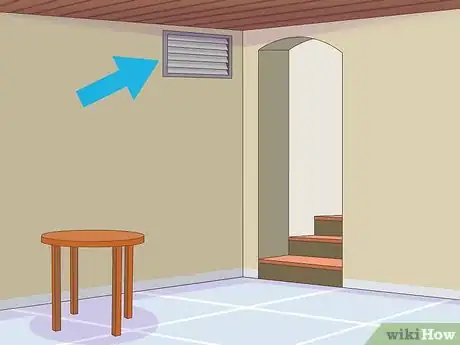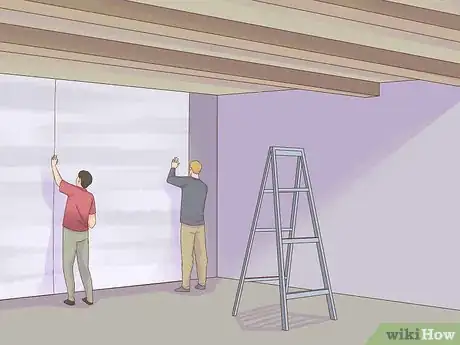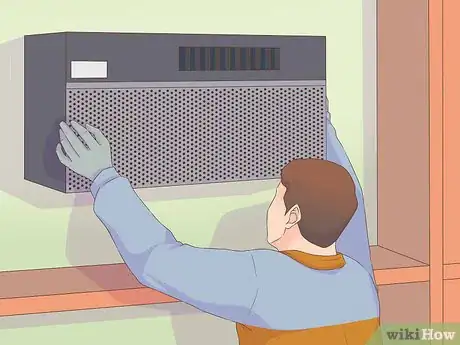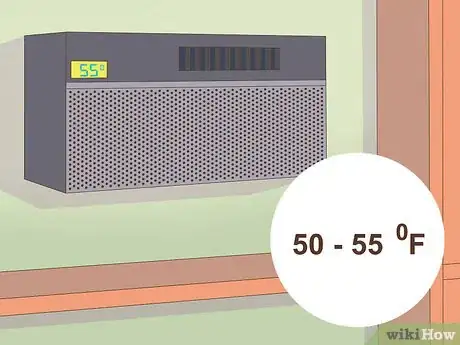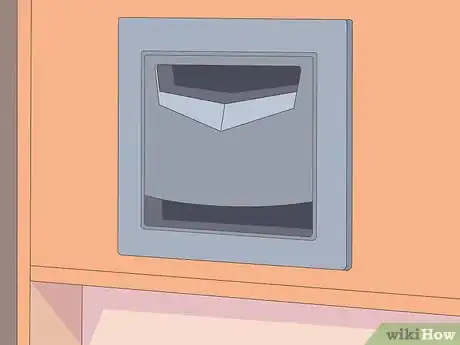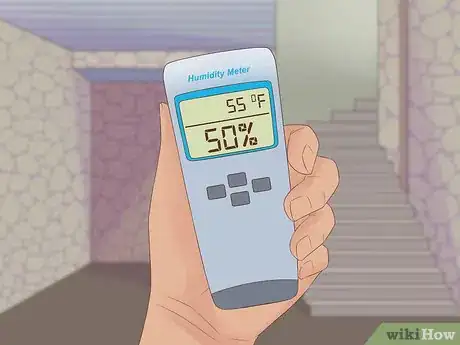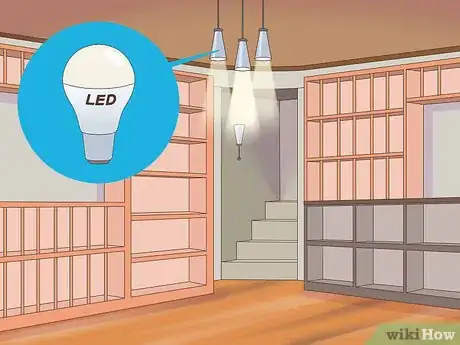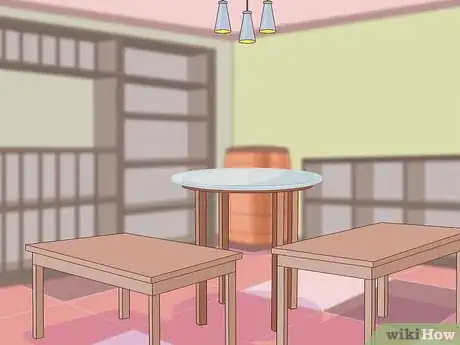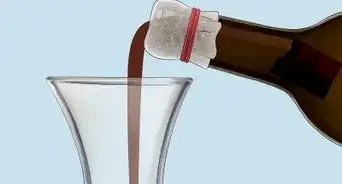This article was co-authored by Murphy Perng. Murphy Perng is a Wine Consultant and the Founder and Host of Matter of Wine, a business that produces educational wine events, including team-building experiences, networking events, and private parties. Based in Los Angeles, California, Murphy has served as a Wine Educator for clients such as Google, Buzzfeed, Tiktok, Snapchat, and Equinox and been featured on National Geographic and The Somm Journal. Murphy possesses her WSET (Wine & Spirit Education Trust) Level 3 Advanced Certification.
There are 17 references cited in this article, which can be found at the bottom of the page.
This article has been viewed 32,500 times.
If you’re a wine connoisseur, a wine cellar can make a perfect addition to your home. The simplest way to build your own wine cellar is to renovate an existing room in your house. First, make sure the space you’ve chosen is properly framed and insulated. Then, purchase and install a specialized cooling system to keep your wine cellar within the optimum temperature and humidity range. When that’s done, you can begin picking out racks, lighting, and other decorative touches to put your own personal stamp on your home wine cellar.
Steps
Constructing Your Wine Cellar
-
1Choose an existing room to convert to a wine cellar. Despite what the term suggests, just about any room can be used as a wine cellar as long as it’s well-insulated. Basements and cellars are among the best choices since they’ll already be cooler than other parts of your home, but you could also use a game room, spare bedroom, or even an unused closet.[1]
- The exact size of your wine cellar will depend on the space you have available, as well as the amount of wine you want to preserve.
- When it comes to wine cellars, the cooler, the better. If possible, pick out a room that receives little or no direct exposure to sunlight throughout the day.
Warning: Don't designate an attic or garage for your wine cellar, as these spaces tend to be difficult to insulate properly.[2]
-
2Make sure the area adjacent to your wine cellar has adequate ventilation. To convert an ordinary room to a wine cellar, you’ll be installing a special cooling system that pumps warm exhaust air into a neighboring room. Try to select a room that contains at least one door, window, or air vent to allow the warm air to escape.[3]
- Most cooling systems only guarantee a 30-50 degree temperature differential. For this reason, it’s important that the adjacent room be no warmer than 85–100 °F (29–38 °C) to maintain the recommended temperature of 50–55 °F (10–13 °C) in the cellar.
- If you’re building your wine cellar in a basement, you won’t have to worry about ventilating any other rooms, as the warm air will simply be dispersed outside.
Advertisement -
3Wrap the entire room with a vapor barrier to repel moisture. Measure the walls and ceiling of your wine cellar and cut sections of waterproof 6mm plastic or foil sheeting to fit over them. Stretch and smooth each section so that it lays as flush as possible. Secure the vapor barrier along the edges with foil-backed tape to ensure that it stays in place.[4]
- Ask someone to assist you when it comes time to apply your barrier materials to the ceiling.
- A preliminary vapor barrier will keep out unwanted moisture that could interfere with the humidity levels in your wine cellar.
-
4Frame the room with wooden joists to prepare it for insulation. Cut a series of 2 in (5.1 cm) x 6 in (15 cm) boards to match the height of the walls. Position the boards vertically around the perimeter of the room on the inside of the vapor barrier, leaving 16 inches (41 cm) of space between each. Secure the joists with 2-3 nails at both the top and bottom ends. Do the same for the ceiling using 2 in (5.1 cm) x 8 in (20 cm) boards.[5]
- You might be able to get away with not framing the ceiling of your space if it's constructed of concrete.
- The purpose of framing is to create enough distance between the outer walls and the room’s interior to install an extra layer of insulation, which will help maintain the right temperature for preservation and aging.
-
5Fill the gaps in your frame with high-efficiency insulation materials. Place 15 in (38 cm) fiberglass or foam batts into the spaces between each of the frame joists. For smaller spaces like closets, you can also use blown-in types of insulation like shredded fiberglass or low-dust cellulose for ease of installation.[6]
- Experts recommend using insulation with a rating of at least R-19 for wine cellar walls, and at least R-30 for ceilings. This means the insulation will be about 5.5 inches (14 cm) thick on each side, with a 10 in (25 cm) layer along the ceiling.[7]
- If you decide to go with a blown-in insulation, be sure to apply an additional vapor barrier to the inside of the frame joists to properly contain it.
-
6Cover the insulated frame with drywall. Once you’ve got your insulation in place, all that’s left to do is hang drywall to complete the basic structure of the room. Score your sheets to the right dimensions with a utility knife, then fasten them to the joists every 12 inches (30 cm) using drywall screws. Use 5-6 screws for each side of each sheet.[8]
- Be sure to tape over the seams between each sheet so they won’t be visible in the finished wall.
- Lightweight gypsum board, or “green board,” can perform the same function as drywall or sheetrock, but with even greater moisture-resistant properties.
-
7Paint the walls of your wine cellar with waterproof paint. Smooth on 2-3 even coats of paint in your shade of choice, allowing each coat to dry for 12-24 hours before applying follow-up coats. For maximum protection and durability, use a polyvinyl acetate (PVA) paint formula. PVA paints offer a smooth, resilient finish and serve as an additional barrier against moisture.[9]
- Painting in small, enclosed spaces increase your risk of exposure to harmful fumes. Be sure to open any nearby doors and windows and leave the air conditioning or a portable fan running to promote ventilation.
- Another possible option is to have wood paneling installed rather than painting. Choose a rot-resistant type of wood, such as redwood, cedar, or pressure-treated pine, to prevent warping as a result of the surrounding humidity.[10]
Creating Optimal Storage Conditions
-
1Have a specialty cooling system installed in your wine cellar. Hire an HVACR technician to come in and set up your cooling system for you. For home use, you’ll get the best results using a split system. These can be mounted directly to the wall of your wine cellar, with one half located inside the cellar itself and the other half situated outside to vent warm air exhaust.[11]
- There are many companies that make air conditioner-style cooling units designed specifically for wine cellars. Spend some time looking into different cooling systems online to find one that suits your individual needs and budget.
- Keep in mind that you'll be paying for the system and the installation separately, which may drive up your total projected expenses.
Tip: If a standard split system is too difficult or pricey to install in your space, you can opt for a more affordable self-contained cooling unit.[12]
-
2Keep your cooling system set to 50–55 °F (10–13 °C). This is the recommended temperature range for preserving and aging wine. If it’s too warm in your wine cellar, your wine can reach peak condition too fast and may be at risk of spoiling. If it’s too cold, your wine may age too slowly or be “shocked,” which can ruin the flavor.[13]
- Wine cooling units work similarly to standard heating and air conditioning systems—they’ll monitor the temperature in the room and increase or decrease the amount of cold air being circulated to keep it within the desired range.
- Of course, temperature varies according to the wine you have. Over time, wine starts losing aromas and flavors. But they gain smoothness, reducing the "kick" of the alcohol and integrating it better into the rest of the wine. This process, while beneficial and desired in some aspects, is a little sped up if your temperature is warmer than it really should be.
-
3Bring in a humidifier if your space is especially dry. It’s possible that the room you’ve selected for your wine cellar may have a lower than ideal humidity, particularly in drier regions. In these cases, it can be a good idea to invest in a separate humidifier unit to keep in one corner of the cellar. The humidifier will supply enough moisture to bring the room to the optimum level of 50-75%.[14]
- Make sure the humidifier you pick out is a non-heating model—you don’t want to raise the temperature of the room by accident.
- You can also introduce a little extra moisture by installing a decorative fountain somewhere in your wine cellar.
-
4Make sure the humidity in your wine cellar remains between 50-75%. The relative humidity of your space is a major concern. Too much humidity can lead to mold growth inside the cellar. Likewise, air that’s too dry can cause corks to crack and split, resulting in your wine being exposed prematurely or even potentially spilling.[15]
- Once you’ve programmed your cooling system, it will automatically work to maintain both the temperature and humidity in your wine cellar.
- With most newer cooling systems, excess moisture in the surrounding environment is condensed and eliminated via a condensate evaporation system. If you prefer, you can also have a separate drain line installed to flush waste water outside.[16]
Incorporating Essential Display Features
-
1Line your wine cellar with racks to store and show off your collection. If you have a particular design in mind to fit the look of your home wine cellar, get in touch with a rack maker to discuss ideas for custom storage solutions. Arrange your racks along the outer walls to maximize walking space, or line them up in the center of the room to create rows.[17]
- For a more cost-effective alternative, you can also shop for premade, ready-to-assemble racks online or in stores that specialize in wine accessories.
- Wine racks come in all different sizes and styles, so be sure to shop around to find a set that speaks to your sensibilities.
Tip: Most connoisseurs prefer wooden wine racks, as metal racks are more likely to scratch or tear labels.
-
2Install showroom-style lighting to highlight prized vintages. Mount light fixtures on the ceiling or floor at regular intervals and position them to point at your racks at upwards or downwards angles. They'll illuminate the selections you’re most proud of in a more impressive fashion than you could with ordinary ceiling lighting.[18]
- Some enthusiasts opt to avoid lighting altogether, since bright light can warm the room and impact the flavor of the wine. If you do decide to include a few decorative fixtures, make sure you use a low-voltage variety, such as fluorescent bulbs or LEDs.[19]
- Be careful not to damage your vapor barrier while installing and situating your light fixtures.
-
3Set aside one corner of your wine cellar to use for tastings. When it comes time to begin decorating your completed wine cellar, set out a table and a few comfortable chairs, or spend a little extra putting in a bar and some stools. That way, you and your friends can get together to enjoy a private sampling or chat over a glass of your finest reserve.[20]
- You could even add a tasting area to a compact wine cellar by installing a short section of countertop with room for a handful of individual racks, similar to a sink in a half-bath.[21]
Things You’ll Need
Constructing Your Wine Cellar
- 6mm plastic or foil sheeting (to act as vapor barrier)
- 2 in (5.1 cm) x 6 in (15 cm) wooden boards
- Fiberglass or foam insulation batts
- Blown-in insulation (optional)
- Drywall, sheetrock, or green board
- PVA paint and primer
- Rot-resistant wood paneling (optional)
Maintaining Optimal Storage Conditions
- Mini-split cooling system
- Non-heating humidifier unit (optional)
Incorporating Essential Display Features
- Wooden or metal wine racks
- Decorative lighting fixtures
- Fluorescent light bulbs or LED lights
- Assorted furniture and accessories
Expert Interview
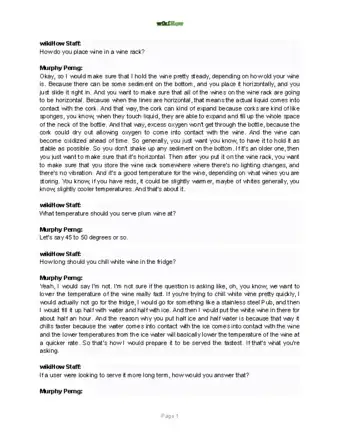
Thanks for reading our article! If you'd like to learn more about wine storage, check out our in-depth interview with Murphy Perng.
References
- ↑ https://www.architypes.net/diy-wine-cellar/
- ↑ https://www.youtube.com/watch?v=SZsUGhqcVM0&feature=youtu.be&t=90
- ↑ https://www.youtube.com/watch?v=SZsUGhqcVM0&feature=youtu.be&t=272
- ↑ https://www.youtube.com/watch?v=SZsUGhqcVM0&feature=youtu.be&t=393
- ↑ https://vigilantinc.com/wine-cellars/building-a-wine-cellar.php
- ↑ https://www.architypes.net/diy-wine-cellar/
- ↑ https://vigilantinc.com/wine-cellars/building-a-wine-cellar.php
- ↑ https://www.winecellarinnovations.com/Files/PDFs/room-construction-guidelines.pdf
- ↑ https://www.youtube.com/watch?v=SZsUGhqcVM0&feature=youtu.be&t=504
- ↑ https://thecraftsmanblog.com/choosing-rot-resistant-wood/
- ↑ https://www.architypes.net/diy-wine-cellar/
- ↑ https://www.youtube.com/watch?v=SZsUGhqcVM0&feature=youtu.be&t=174
- ↑ https://www.youtube.com/watch?v=SZsUGhqcVM0&feature=youtu.be&t=115
- ↑ https://www.youtube.com/watch?v=SZsUGhqcVM0&feature=youtu.be&t=331
- ↑ https://www.vinology.com/wine-cellar/
- ↑ https://www.youtube.com/watch?v=SZsUGhqcVM0&feature=youtu.be&t=322
- ↑ https://vigilantinc.com/wine-cellars/building-a-wine-cellar.php
- ↑ https://www.youtube.com/watch?v=SZsUGhqcVM0&feature=youtu.be&t=473
- ↑ http://www.winecellarinternationalblog.com/forget-incandescent-bulbs-stick-to-led-lights-for-beautiful-wine-cellar-displays-great-savings-and-quality-wine/
- ↑ https://www.elledecor.com/design-decorate/room-ideas/g22666289/wine-rooms-and-displays/
- ↑ https://www.winecellarinnovations.com/Files/PDFs/room-construction-guidelines.pdf
- ↑ https://www.costowl.com/home-improvement/other-wine-cellar-cost.html
